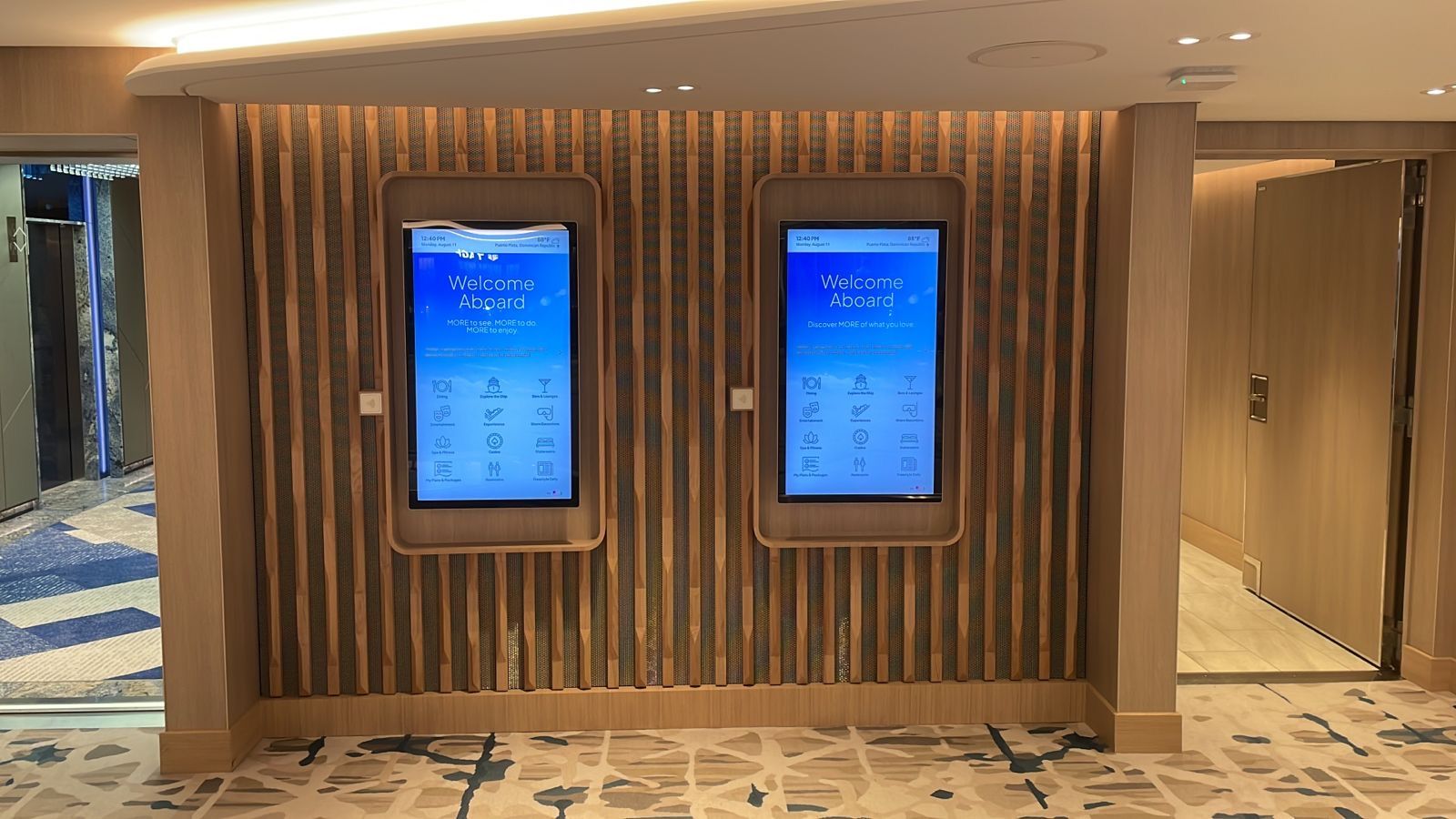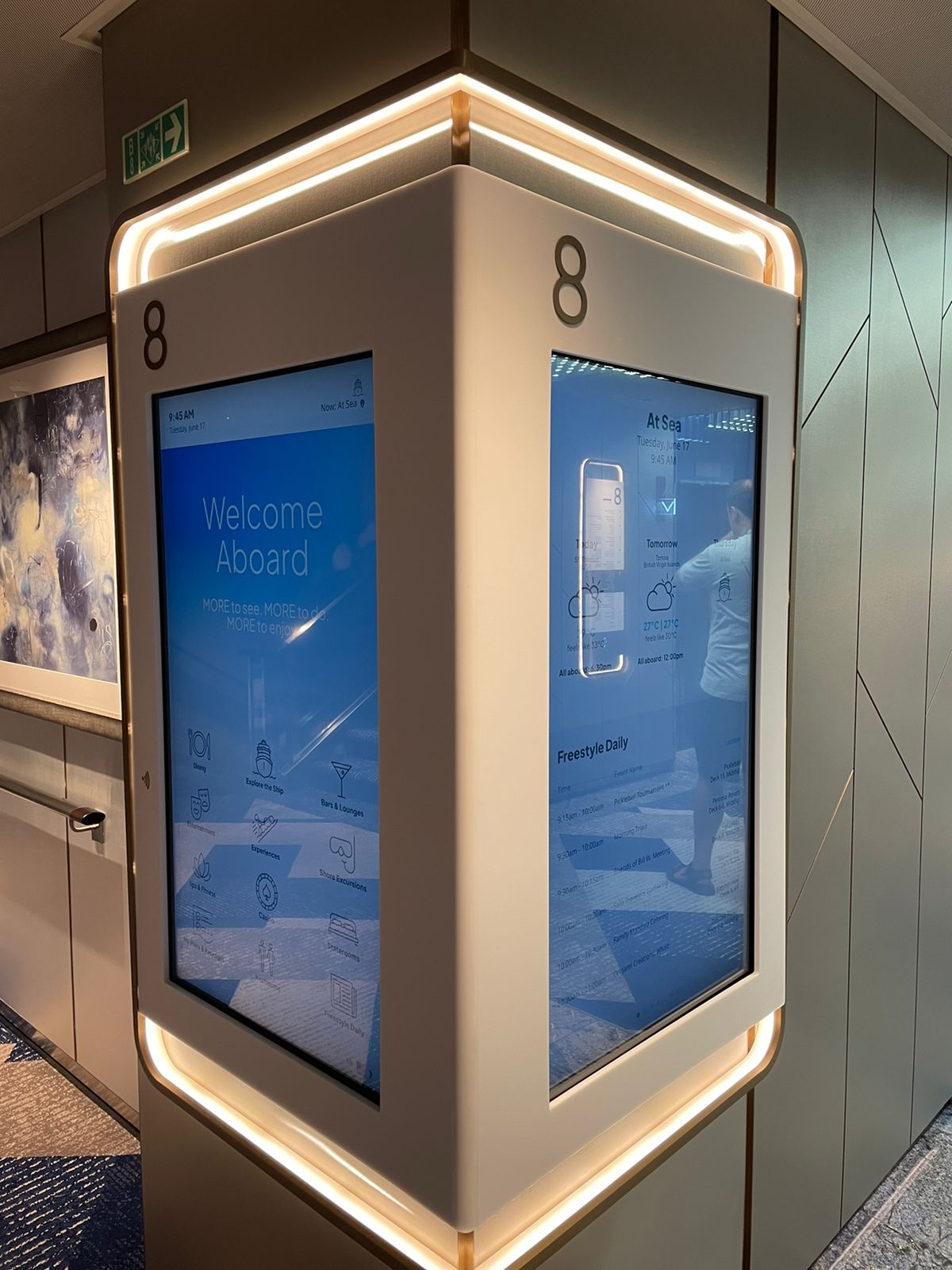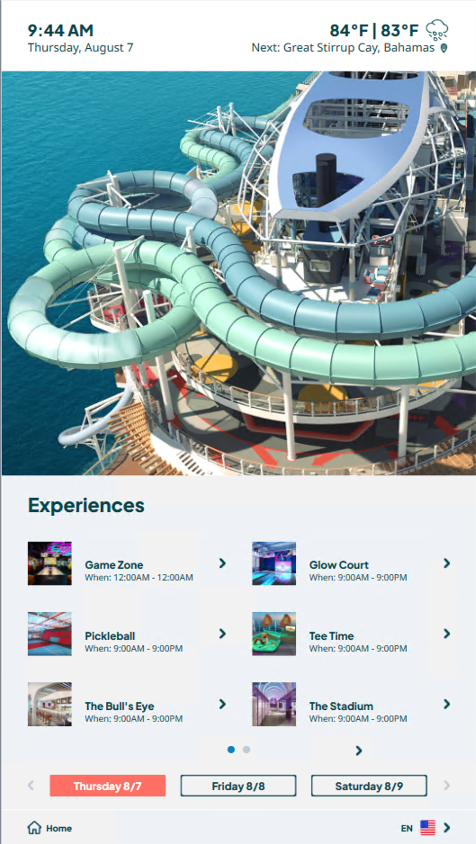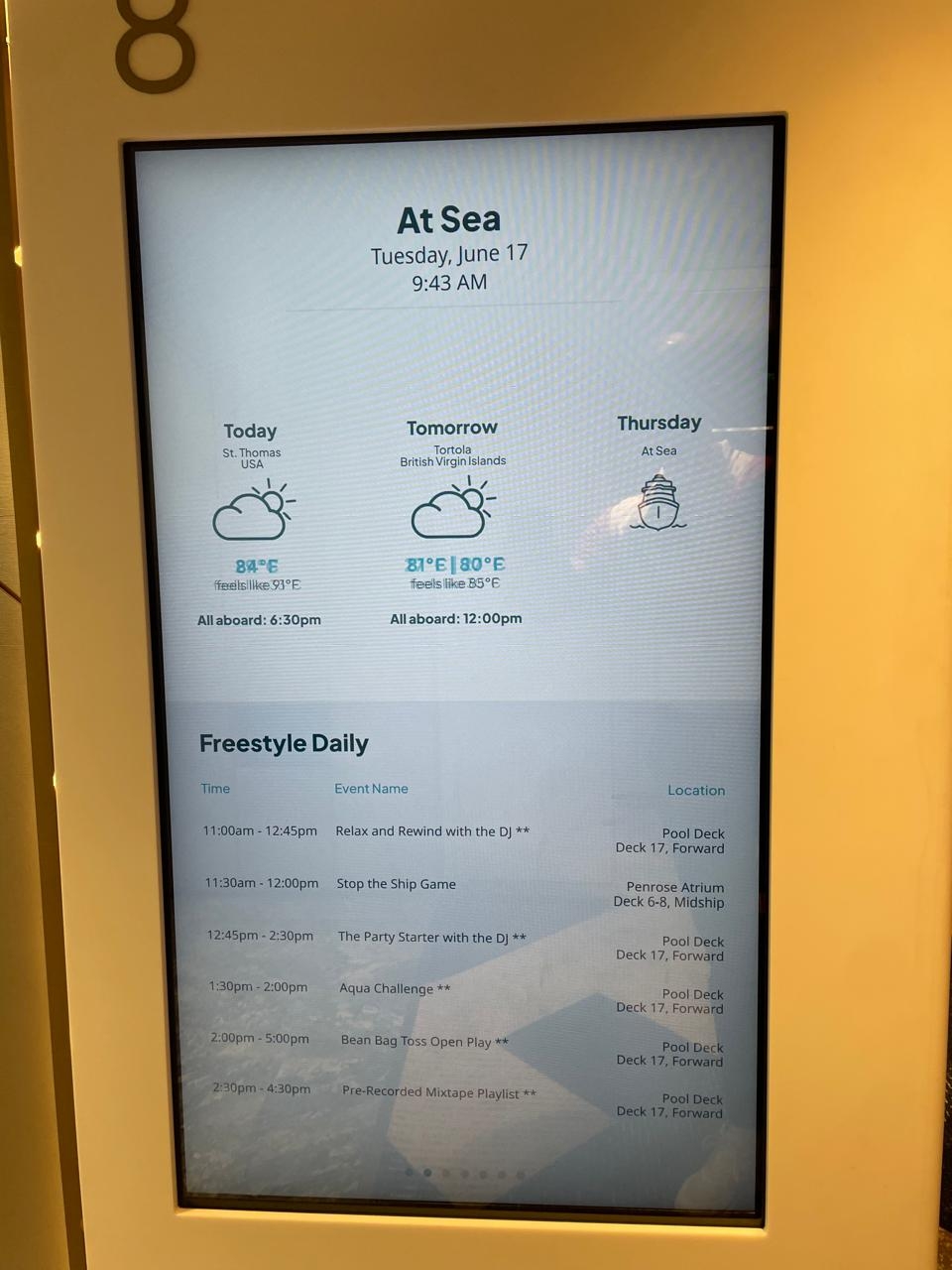Cruising to a Better Guest Experience: A Deeper Look Into Norwegian Cruise Line’s Fleet-Wide Digital Signage Network
Dive deeper into the strategy, use cases, and impact of Norwegian Cruise Line’s 2,900 fleet-wide digital signage network.
↓

About the organization
Norwegian Cruise Line is a global cruise operator with a fleet of 20 ships visiting hundreds of destinations worldwide, serving over 2.9 million passengers annually.
Location
North America
Industry
Hospitality
No of Employees
41000 +
Introduction
Norwegian Cruise Line (NCL) has revolutionized its onboard communication and guest experience through an innovative digital signage implementation across its fleet of 20 ships. This comprehensive network, powered by Poppulo since 2009, comprises 2,900 digital signs, with newer ships each featuring more than 200 displays. While this investment in enhancing passenger satisfaction started more than 16 years ago, NCL continues to innovate and find new ways to drive value with its digital signage network.

The Challenge
When it comes to managing thousands of screens on ships sailing around the world, the challenges are plentiful—ranging from internet connectivity and the need for region-specific data to display, to cohesive branding, and more. The reality for NCL is that digital signage is a critical component of the guest experience. Throughout its fleet, signs are used for wayfinding, enabling dining, activities, and excursion booking, keeping guests informed about a variety of other things, and even staff communication. While the application set for each ship is impressive, it’s the day-to-day content deployment and management that has always been time-consuming. NCL needed to reduce the workload on staff while simultaneously improving guest satisfaction and ensuring fleet standardization, a delicate balance in the cruise industry. Additionally, NCL also had to address the need for multilingual communication to cater to its diverse international clientele and find ways to maximize onboard revenue through targeted promotions and advertisements.

The Solution
To address these challenges and create a more cohesive, impactful guest experience, NCL elected to migrate from Poppulo’s legacy digital signage product to its cloud-based platform. The migration started in 2022, with the launch of Norwegian Prima, followed by a systematic retrofit of existing ships during scheduled dry docks. Today, 15 ships have been migrated to the new system, with the remaining 5 scheduled to be complete in 2026.
In addition to the software migration, NCL upgraded its players from Windows 7 to Windows 10, with the hardware and software update happening simultaneously for retrofitted ships. The overall migration project also included new template creation, which encompassed updated branding, as well as integrations for NCL’s new property management system. These updates combined to uplevel the fleet’s ability to provide an exceptional guest experience, drive revenue, reduce content management time, and innovate at scale.
On top of the software and hardware, NCL relies on Poppulo’s Communication Engagement Management (CEM), a managed service which provides software and strategy expertise. NCL uses their dedicated CEM resource for two main things—advanced technical support and system-wide strategic enhancements. While all ships have IT on board for overall network and connectivity help, and NCL’s shore-based digital signage team is available for support, for anything that requires more advanced expertise, NCL engages its dedicated CEM resource. And when it comes to strategic enhancements, there are seemingly endless ways to leverage digital signage to improve the guest experience and drive revenue. Some enhancement projects Poppulo’s CEM team worked on include the creation of a countdown timer for a lottery drawing that’s shared across all ships in the fleet, template upgrades, new signage form factors, and even testing hardware compatibility for new players like the Amazon Signage Stick. Reflecting on NCL’s partnership with Poppulo, Michael McKay, Director of New Build Innovation Technology at Norwegian Cruise Line Holdings, stated "Poppulo has been one of our best vendors consistently. Our Digital Signage system has been extremely reliable, and anytime we need help, they're always there. Poppulo has and continues to support our digital guest experience."

A Deeper Look at Norwegian Cruise Line’s Digital Signage Network
At the heart of this network are interactive wayfinding kiosks strategically placed on elevator landings and in high-traffic areas. These kiosks serve as digital concierges, helping guests navigate the vast ships with ease and providing real-time information on dining availability, entertainment and activity schedules, port & weather information, and shore excursions.
The implementation extends beyond interactive displays to include non-interactive screens for menus, buffet information, casino updates, and department-specific content, as well as employee-facing content in staff congregation areas. While all ships are unique, Micheal said, "Our newer ships are running around about 200 to 225 displays. It's a mix of both touch screen and non-interactive screens throughout the ship, covering everything from interactive kiosks to menu boards, buffet signage, casino signage, and department-specific content." This diverse array of digital touchpoints ensures that guests are always informed about the latest offerings and events onboard.
In addition to the applications NCL uses across its fleet, the team also leverages Poppulo’s takeover functionality to ensure guests have access to critical information at exactly the right time. Of these takeovers, the most common include information about assembly stations, gangway locations, and time-specific promotions.

The Results
The system's integration with NCL's property management system allows for real-time updates on dining, entertainment, and shore excursions, ensuring that the information displayed is always accurate and up-to-date. However, it’s not just the ability to display data from its property management system that makes a difference—the interactive wayfinding kiosks that show excursions and empower guests to book also automatically remove excursions once they are full, and remove certain listings a pre-defined amount of time before the excursion takes place. The system automatically removes listings from non-interactive promotional screens if the date or time of the event has passed. This reduces guest frustration while empowering guests to take full advantage of the activities available to them. “Each of our ships sets up their core content schedule at the beginning of the season, then the screens are automatically updated based on a variety of parameters, ensuring guests always have access to the most relevant information,” Michael stated. “For example, all of our menus have pricing on them. In the past, when we were relying on each ship to update that type of content, updates could sometimes get missed, potentially leading to decreased guest satisfaction. Now that it is centralized and pre-scheduled, we don't have to worry about it, and we ensure our guests see the most up-to-date information. By removing administrative tasks like updating menus and content from our crew and putting it into the cloud, we're able to have our crew focus more on what matters—interacting with our guests. That's our secret sauce."
While there are a number of ways to book entertainment, dining, and excursions, digital signage remains one of the most used options across the fleet. From January through June, 2025, over 6,700 dining reservations, 11,500 entertainment reservations, and 5,400 excursions were booked directly from NCL’s digital signs. This accounts for approximately 40% of reservations made onboard. Additionally, the signs are now able to show personalized information, including entitlement information, enabling guests to see what is included in their cruise package, which further enhances guest satisfaction. And beyond revenue-generating uses, guests interacted with the screens more than 6.3 million times across the fleet within the same 6-month timeframe, further showing how NCL’s digital signs are a critical component of the guest experience.
Operationally, NCL has seen a remarkable 75% reduction in time spent on fleet-wide template updates. Reflecting on the time savings, Michael stated, “By moving to a centralized cloud system, we've reduced our template maintenance and content management time significantly. It's been a massive time-saver." This streamlined process has freed up valuable resources, allowing crew members to focus more on direct guest interactions rather than administrative tasks. The cloud-based content management system has ensured consistency in messaging and branding across all ships, maintaining NCL's brand integrity across its global operations. Instead of logging into each ship’s system and updating content manually, Michael’s team can assign templates across the fleet and even assign content to playlists, ensuring the right information shows up on the right ships—all in a fraction of the time it used to take. While onboard staff have access to make content updates if needed, most of the content management happens centrally.
Looking to the future, NCL is not content to maintain the status quo. The company is exploring new digital signage form factors, exploring expanded reporting and efficiencies offered in Poppulo’s future releases, and increasing its use of digital signage for its shore-based employees. These initiatives demonstrate NCL's commitment to continually enhancing its digital ecosystem to meet evolving guest expectations and operational needs.
Norwegian Cruise Line's fleet-wide digital signage network represents a significant leap forward in the cruise industry's approach to guest communication and experience management. By leveraging Poppulo’s cloud-based technology and centralized content management, NCL has not only enhanced the guest experience but also improved operational efficiency and driven revenue growth.
Explore other stories
WPP Enterprise Technology Communications Team Leads the Way with Increased Engagement and Efficiency
Poppulo delivers “night-to-day” change in revolutionizing colleague communication capabilities
Dive deeper into the strategy, use cases, and impact of Norwegian Cruise Line’s 2,900 fleet-wide digital signage network.
As the company expanded its global footprint and adopted a hybrid work model, the need for a scalable, cohesive, and engaging multi-channel internal communications strategy became increasingly important.


